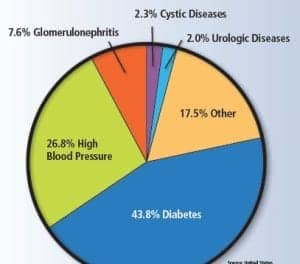Scientists at Joslin Diabetes Center have identified two novel markers that, when elevated in the blood stream, can predict accurately the risk of renal (kidney) failure in patients with Type 1 and Type 2 diabetes. The findings have immediate diagnostic implications and can be used for the development of new therapies to prevent or postpone the progression of renal disease in diabetes.
In two studies published in the Journal of the American Society of Nephrology, the Joslin researchers found that high concentrations of Tumor Necrosis Factor Receptor 1 and 2 (TNFR1 and TNFR2) accurately predict the risk of renal function loss in Type 1 and in Type 2 diabetes 10 years in advance. Currently available clinical tests cannot identify people at risk with that level of precision.
“These markers are excellent predictors of early and late renal function decline in patients with diabetes,” says senior author Andrzej Krolewski, MD, PhD, section head of Genetics and Epidemiology at Joslin.“ Our findings may improve clinical care for patients who are at risk of kidney damage.”
In one study, Krolewski and his colleagues followed 410 patients with Type 2 diabetes for eight to 12 years and found that those at risk of ESRD had elevated concentrations of TNFR1 and TNFR2 in their blood. That prompted them to investigate whether circulating TNFR1 and TNFR2 are also indicators of early renal function decline in Type 1 diabetes. Their subsequent study of 628 patients with Type 1 diabetes similarly found that those with high levels of TNFR1 and TNFR2 were at higher risk of early stages of renal function loss. Elevated levels of these protein receptors led to renal disease in diabetic patients, regardless of the presence or absence of other clinical characteristics that are considered important risk factors for diabetic nephropathy.
At the beginning of the studies, the researchers measured several dozen inflammatory markers in more than a thousand subjects with diabetes, monitored these individuals, and collected data on whether their renal function declined and, more importantly, if they developed renal failure and required dialysis or transplantation. The researchers discovered that the effect of TNFR1 and TNFR2 on renal function was distinct from other markers or clinical measurements, such as blood pressure, albuminuria (a leak of large amount of albumin into urine) and glycated hemoglobin, which are currently evaluated in doctors’ offices. The scientists do not know how or why TNF receptors contribute to the injury of the diabetic kidney, but preliminary data suggests that the effect of TNFR1 and TNFR2 expands beyond the simple effect of TNFα mediation.
These studies were supported by funding from National Institutes of Health (NIH) and Juvenile Diabetes Research Foundation (JDRF), as well as other fellowships and grants.
Source: Joslin Diabetes Center




